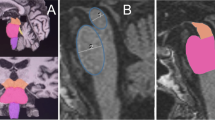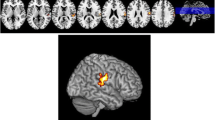Abstract
Postmortem studies on patients with Alzheimer’s disease (AD) have confirmed that the dorsal raphe nucleus (DRN) in the brainstem is the first brain structure affected in the earliest stage of AD. The present study examined the brainstem in the early stage of AD using magnetic resonance (MR) imaging. T1-weighted MR images of the brains of 81 subjects were obtained from the publicly available Open Access Series of Imaging Studies (OASIS) database, including 27 normal control (NC) subjects, 27 patients with very mild AD (AD-VM) and 27 patients with mild AD (AD-M). The brainstem was interactively segmented from the MR images using ITK-SNAP. The present voxel-based morphometry (VBM) study was designed to investigate the brainstem differences between the AD-VM/AD-M groups and the NC group. The results showed bilateral loss in the pons and the left part of the midbrain in the AD-M group compared to the NC group. The AD-M group showed greater loss in the left midbrain than the AD-VM group (PFWEcorrected < 0.05). The results revealed that brainstem atrophy occurs in the early stages of AD (Clinical Dementia Rating = 0.5 and 1.0). Most of these findings were also investigated in a multicenter dataset. This is the first VBM study that provides evidence of brainstem alterations in the early stage of AD.





Similar content being viewed by others
References
Ashburner, J., & Friston, K. J. (2000). Voxel-based morphometry-the methods. Neuroimage, 11, 805–821.
Attems, J., Thomas, A., & Jellinger, K. (2012). Correlations between cortical and subcortical tau pathology. Neuropathology and Applied Neurobiology, 38, 582–590.
Buckner, R. L., Head, D., Parker, J., Fotenos, A. F., Marcus, D., Morris, J. C., & Snyder, A. Z. (2004). A unified approach for morphometric and functional data analysis in young, old, and demented adults using automated atlas-based head size normalization: Reliability and validation against manual measurement of total intracranial volume. Neuroimage, 23, 724–738.
Busatto, G. F., Diniz, B. S., & Zanetti, M. V. (2008). Voxel-based morphometry in Alzheimer’s disease. Expert Review of Neurotherapeutics, 8, 1691–1702.
Celle, S., Delon-Martin, C., Roche, F., Barthélémy, J. C., Pépin, J. L., & Dojat, M. (2016). Desperately seeking grey matter volume changes in sleep apnea: A methodological review of magnetic resonance brain voxel-based morphometry studies. Sleep Medicine Reviews, 25, 112–120.
Chetelat, G., & Baron, J. C. (2003). Early diagnosis of Alzheimer’s disease: Contribution of structural neuroimaging. NeuroImage, 18, 525–541.
Fischl, B. (2012). Freesurfer. Neuroimage, 62, 774–781.
Fotenos, A. F., Snyder, A. Z., Girton, L. E., Morris, J. C., & Buckner, R. L. (2005). Normative estimates of cross-sectional and longitudinal brain volume decline in aging and AD. Neurology, 64, 1032–1039.
Grinberg, L., Rüb, U., Ferretti, R., Nitrini, R., Farfel, J., Polichiso, L., Gierga, K., Jacob-Filho, W., Heinsen, H., & Brazilian Brain Bank Study Group. (2009). The dorsal raphe nucleus shows phospho-tau neurofibrillary changes before the transentorhinal region in Alzheimer’s disease. A precocious onset? Neuropathology and Applied Neurobiology, 35, 406–416.
Grinberg, L. T., Rueb, U., & Heinsen, H. (2011). Brainstem: Neglected locus in neurodegenerative diseases. Frontiers in Neurology, 2, 42.
Grudzien, A., Shaw, P., Weintraub, S., Bigio, E., Mash, D. C., & Mesulam, M. M. (2007). Locus coeruleus neurofibrillary degeneration in aging, mild cognitive impairment and early Alzheimer’s disease. Neurobiology of Aging, 28, 327–335.
Hellström-Lindahl, E., Viitanen, M., & Marutle, A. (2009). Comparison of Aβ levels in the brain of familial and sporadic Alzheimer’s disease. Neurochemistry International, 55, 243–252.
Hwang, J., Kim, J., Han, Y., & Park, H. (2011). An automatic cerebellum extraction method in T1-weighted brain MR images using an active contour model with a shape prior. Magnetic Resonance Imaging, 29, 1014–1022.
Karas, G., Scheltens, P., Rombouts, S., van Schijndel, R., Klein, M., Jones, B., van der Flier, W., & Barkhof, F. (2007). Precuneus atrophy in early-onset Alzheimer’s disease: a morphometric structural MRI study. Neuroradiology, 49, 967–976.
Kinkingnéhun, S., Sarazin, M., Lehéricy, S., Guichart-Gomez, E., Hergueta, T., & Dubois, B. (2008). VBM anticipates the rate of progression of Alzheimer disease: A 3-year longitudinal study. Neurology, 70, 2201–2211.
Lee, J. H., Ryan, J., Andreescu, C., Aizenstein, H., & Lim, H. K. (2015). Brainstem morphological changes in Alzheimer’s disease. Neuroreport, 26, 411–415.
Marcus, D. S., Wang, T. H., Parker, J., Csernansky, J. G., Morris, J. C., & Buckner, R. L. (2007). Open access series of imaging studies (OASIS): Cross-sectional MRI data in young, middle aged, nondemented, and demented older adults. Journal of Cognitive Neuroscience, 19, 1498–1507.
Morris JC (1993) The clinical dementia rating (CDR): Current version and scoring rules. Neurology, 43, 2412b-2414b.
Mrzilková, J., Zach, P., Bartoš, A., Tintěra, J., & Řípová, D. (2012). Volumetric analysis of the pons, cerebellum and hippocampi in patients with Alzheimer’s disease. Dementia and Geriatric Cognitive Disorders, 34, 224–234.
Mungas, D., Reed, B. R., Jagust, W. J., DeCarli, C., Mack, W. J., Kramer, J. H., Weiner, M. W., Schuff, N., & Chui, H. C. (2002). Volumetric MRI predicts rate of cognitive decline related to AD and cerebrovascular disease. Neurology, 59, 867–873.
Musa, G., Henríquez, F., Muñoz-Neira, C., Delgado, C., Lillo, P., & Slachevsky, A. (2017). Utility of the neuropsychiatric inventory questionnaire (NPI-Q) in the assessment of a sample of patients with Alzheimer’s disease in Chile. Dement Neuropsychol, 11(2), 129–136.
Paul, A. Y., Joseph, P., Heather, C. H., Rachel, G. S., Sean, H., James, C. G., & Guido, G. (2006). User-guided 3D active contour segmentation of anatomical structures: Significantly improved efficiency and reliability. Neuroimage, 31, 1116–1128.
Ridgway, G. R., Henley, S. M., Rohrer, J. D., Scahill, R. I., Warren, J. D., & Fox, N. C. (2008). Ten simple rules for reporting voxel-based morphometry studies. NeuroImage, 40, 1429–1435.
Rodríguez, J. J., Noristani, H. N., & Verkhratsky, A. (2012). The serotonergic system in ageing and Alzheimer’s disease. Progress in Neurobiology, 99, 15–41.
Rüb, U., Del, T. K., Schultz, C., Thal, D., Braak, E., & Braak, H. (2000). The evolution of Alzheimer’s disease-related cytoskeletal pathology in the human raphe nuclei. Neuropathology and Applied Neurobiology, 26, 553–567.
Rubin, E. H., Storandt, M., Miller, J. P., Kinscherf, D. A., Grant, E. A., Morris, J. C., & Berg, L. (1998). A prospective study of cognitive function and onset of dementia in cognitively healthy elders. Archives of Neurology, 55, 395–401.
Samuraki, M., Matsunari, I., Chen, W. P., Yajima, K., Fujikawa, A., Takeda, N., Nishimura, S., Matsuda, H., & Yamada, M. (2007). Partial volume effect-corrected FDG-PET and grey matter volume loss in patients with mild Alzheimer’s disease. European Journal of Nuclear Medicine and Molecular Imaging, 34, 1658–1669.
Schuff, N., Woerner, N., Boreta, L., Kornfield, T., Shaw, L., Trojanowski, J., Thompson, P. M., Jack Jr., C. R., Weiner, M. W., & Alzheimer’s Disease Neuroimaging Initiative. (2009). MRI of hippocampal volume loss in early Alzheimer’s disease in relation to ApoE genotype and biomarkers. Brain, 132, 1067–1077.
Shi, F., Liu, B., Zhou, Y., Yu, C., & Jiang, T. (2009). Hippocampal volume and asymmetry in mild cognitive impairment and Alzheimer’s disease: Meta analyses of MRI studies. Hippocampus, 19, 1055–1064.
Tae, W. S., Kim, S. S., Lee, K. U., Nam, E. C., & Kim, K. W. (2008). Validation of hippocampal volumes measured using a manual method and two automated methods (Freesurfer and IBASPM) in chronic major depressive disorder. Neuroradiology, 50, 569–581.
Takao, H., Hayashi, N., & Ohtomo, K. (2014). Effects of study design in multi-scanner voxel-based morphometry studies. NeuroImage, 84, 133–140.
Walhovd, K. B., Fjell, A. M., Reinvang, I., Lundervold, A., Dale, A. M., Eilertsen, D. E., Quinn, B. T., Salat, D., Makris, N., & Fischl, B. (2005). Effects of age on volumes of cortex, white matter and subcortical structures. Neurobiology of Aging, 26, 1261–1270.
Wang, J. Y., Ngo, M. M., Hessl, D., Hagerman, R. J., & Rivera, S. M. (2016). Robust machine learning-based correction on automatic segmentation of the cerebellum and brainstem. PLoS One, 11, e0156123.
Weier, K., Beck, A., Magon, S., Amann, M., Naegelin, Y., Penner, I. K., Thürling, M., Aurich, V., Derfuss, T., Radue, E. W., Stippich, C., Kappos, L., Timmann, D., & Sprenger, T. (2012). Evaluation of a new approach for semi-automatic segmentation of the cerebellum in patients with multiple sclerosis. Journal of Neurology, 259, 2673–2680.
Wilson, R. S., Nag, S., Boyle, P. A., Hizel, L. P., Yu, L., Buchman, A. S., Shah, R. C., Schneider, J. A., Arnold, S. E., & Bennett, D. A. (2013). Brainstem aminergic nuclei and late-life depressive symptoms. JAMA Psychiatry, 70, 1320–1328.
Wright, I. C., McGuire, P. K., Poline, J. B., Travere, J. M., Murray, R. M., Frith, C. D., Frackowiak, R. S., & Friston, K. J. (1995). A voxel-based method for the statistical analysis of gray and white matter density applied to schizophrenia. Neuroimage, 2, 244–252.
Zhang, Y., Brady, M., & Smith, S. (2001). Segmentation of brain MR images through a hidden Markov random field model and the expectation maximization. IEEE Trans. on Medical Imaging, 20, 45–57.
Zhu, M., Gao, W., Wang, X., Chen, S., & Lin, Z. (2012). Progression of corpus callosum atrophy in early stage of Alzheimer’s disease: MRI based study. Academic Radiology, 19, 512–517.
Zhu, M., Wang, X., Gao, W., Chen, S., Ge, H., Shen, H., & Lin, Z. (2014). Corpus callosum atrophy and cognitive decline in early Alzheimer’s disease: Longitudinal MRI. Dementia and Geriatric Cognitive Disorders, 37, 214–222.
Funding
This study was founded by the Science and Technology Cooperation Direction Project of Hainan Key Research and Development Plan (grant number ZDYD2019207) and National Natural Science Foundation of China (grant numbers 81171304, 81201150 and 81500924). It was also supported by Sanya Key Laboratory Construction (grant number L1232) and Natural Science Foundation of Hainan Province of China (grant number 20158306). The OASIS dataset used in this work was funded by grants (P50 AG05681, P01 AG03991, R01 AG021910, P50 MH071616, U24 RR021382, R01 MH56584). Data used in preparation of this article were obtained from the ADNI database (adni.loni.usc.edu). As such, the investigators within the ADNI contributed to the design and implementation of ADNI and/or provided data but did not participate in analysis or writing this report. A complete listing of ADNI investigators can be found at http://adni.loni.usc.edu/wp-content/uploads/how_to_apply/ADNI_Acknowledgement_List.pdf.
Author information
Authors and Affiliations
Consortia
Contributions
Author contributions included conception and study design (Wenpeng Gao and Xiaoguang Chen), data collection or acquisition (Xiaoxi Ji, Hong Zhang and Yingjie He), statistical analysis (Xiaoxi Ji, Hui Wang and Minwei Zhu), interpretation of results (Xiaoxi Ji, Hui Wang, Minwei Zhu, Wenpeng Gao), drafting the manuscript work or revising it critically for important intellectual content (Xiaoxi Ji, Minwei Zhu, Wenpeng Gao, Xiaoguang Chen and Yili Fu) and approval of final version to be published and agreement to be accountable for the integrity and accuracy of all aspects of the work (All authors).
Corresponding authors
Ethics declarations
This article does not contain any studies with human participants performed by any of the authors.
Conflict of interest
The authors declare they have no conflict of interest.
Additional information
Publisher’s note
Springer Nature remains neutral with regard to jurisdictional claims in published maps and institutional affiliations.
Rights and permissions
About this article
Cite this article
Ji, X., Wang, H., Zhu, M. et al. Brainstem atrophy in the early stage of Alzheimer’s disease: a voxel-based morphometry study. Brain Imaging and Behavior 15, 49–59 (2021). https://doi.org/10.1007/s11682-019-00231-3
Published:
Issue Date:
DOI: https://doi.org/10.1007/s11682-019-00231-3




